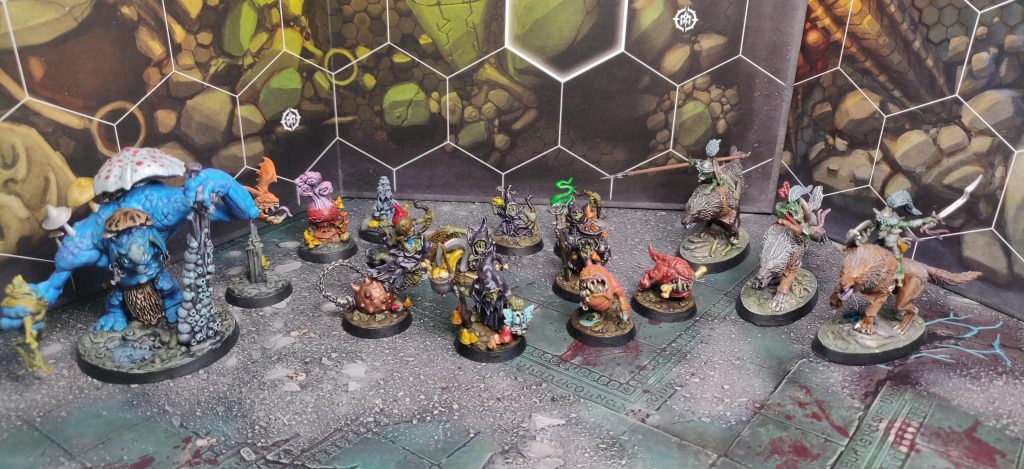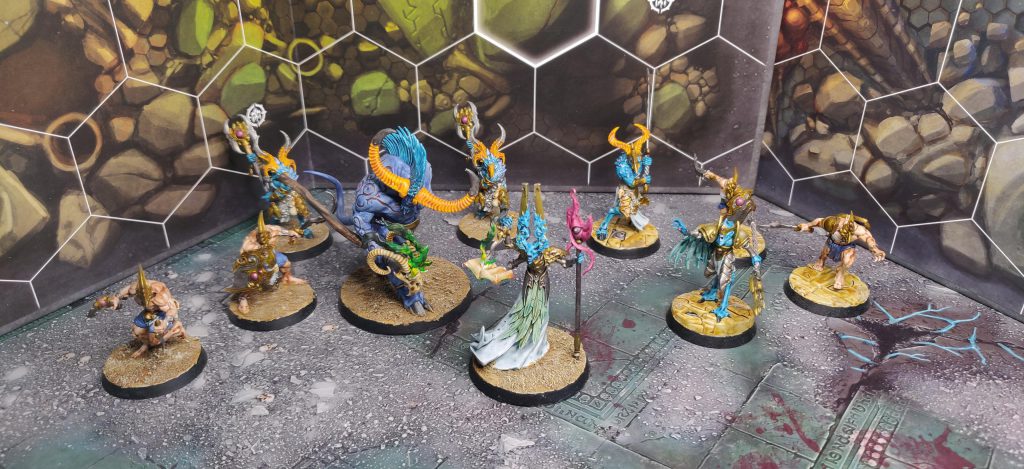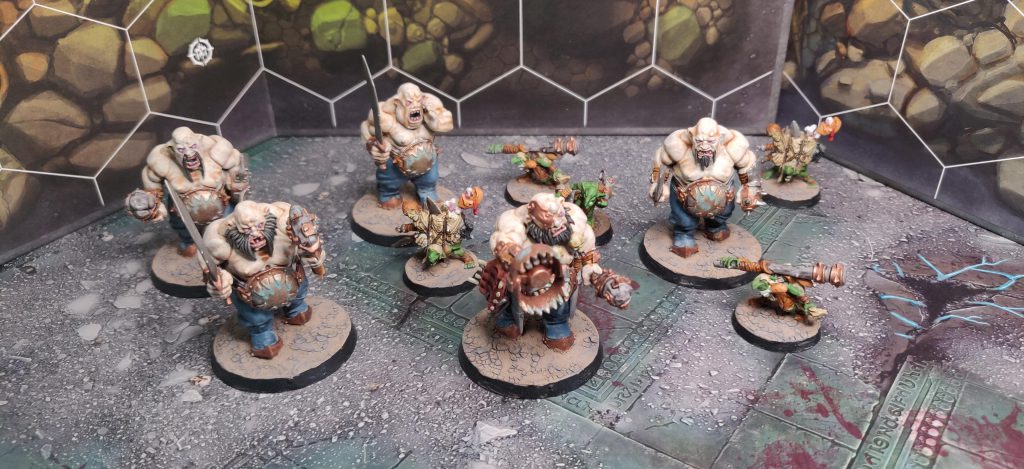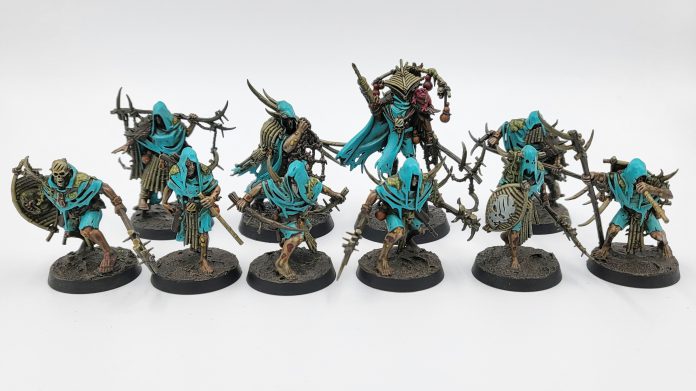It’s a new season of Warcry, and there’s a lot to be excited about! Point changes, fighter changes, Monsters, Thralls, and some nice little rule cleanups are all excellent to have. And better yet, they kept the tight, violent core rules intact, so the game will be just as fun as it’s always been. But there’s one change that’s jumped out more than the others – the inclusion of Reactions.
How do they work?
Like in the previous edition of Warcry, each fighter gets two (2) Actions per turn. However, now a fighter may use one (or even both!) of those actions during an enemy fighter’s activation, as long as the reaction conditions are met. If a fighter chooses to do so, they use one of their unused actions for this turn, so they’ll only have one for their activation later. If you use both reactions before a fighter activates, they’re done for the turn. This also means that if a fighter activates, they can’t do any reactions for the turn. This adds a touch of depth to the previously straightforward Warcry, making you consider activating your fighters in a different order or with different intent than you previously might.

There are three Universal Reactions, which any fighter can use. These are fairly self explanatory, but how often will you actually use them?
Counter looks amazing on the surface – hit back simultaneously when you’re attacked, but more scrutiny shows the relative weakness of it. You trade an action for the chance to do some minimal damage. That action could have been an Attack, and almost assuredly your fighter has better attack damage output than counter can provide. However, it also depends on what your opponent is rolling – if you have a primarily ranged fighter and your opponent runs up with a weak fighter hitting on 5+, the damage on average might be comparable.
Mostly, counter is going to be used by leaving out weak fighters un-activated, and using counter to hit back against a big enemy likely to kill them in one go. This allows you to get at least some damage in while your better fighters do things around the map.
Take Cover is a bit on the weak side overall. There’s a positional requirement, and ranged attacks hit a few nerfs in this edition, so it’s unlikely that you’ll be facing a whole lot of guns. And then it’s a random chance to go off anyways! The only time you’ll be burning this is if you have an objective squatting fighter who really, really needs to survive some gunfire.
Strike them Down is probably the most interesting of the three. It’s very swingy – two different dice rolls with wildly variable damage output – put the potential to just cut down a weak, retreating enemy without having to move after can possibly be devastating.
Overall, you won’t always be using these reactions over your regular actions, but they’re nice tools to have up a sleeve to mix up gameplay.
Faction Reactions – What did I get?
So, with every Faction getting their own Reaction, how did everyone weigh out? Broadly, Reactions fall into a few categories:
- Slightly better versions of Universal Reactions
- Movement Reactions
- Dice/Utility Reactions
- Survivability Reactions
Of these, movement seems to be the best – after all, you’re often using your action to Move, this just lets you do it when your opponent might not be expecting it. Especially if you can use your reaction to give a move to another fighter!
Survivability options often are less useful. After all, moving and fighting are usually better uses of your actions than just trying not to die, and many of the options presented here ended up pretty mediocre in design as well. However, there are a few standouts worth noting.
The other two slightly broader buckets rather understandably vary in power depending on what they actually do. Generally, they are pretty strong, as non-standard utility gives you options that other factions don’t have access to.
Let’s jump into it!
Top Tier Reactions

These are Reactions you’ll almost always use in-game and actively consider when building your list.
CoS: Living City get to make a Disengage after a melee attack occurs. While this isn’t always going to be used, being able to prevent a double attack is potentially game changing. If your opponent is already engaged with you, takes the swing, and you jump out before they get the next one in? That’s a net positive, especially if you have the range to setup for an attack back yourself!
CoS: Tempest’s Eye get the super unique ability to react to an enemy moving nearby to gain an extra Wild Dice! I’d absolutely trade an action on one of my weaker fighters to get a Wild Dice for next turn most of the time, especially when Cities have a number of cheap Fighters that just want to hang out to score and don’t need to fight too much.
Fyreslayers, Gloomspite Gitz, Ironjawz, Cypher Lords, and Bonesplitterz all have the ability to make a bonus move on another friendly fighter when an enemy moves within 3″ of a fighter. These vary a bit, depending on who can move and how close they have to be to the reacting fighter, but giving up an action on a cheaper fighter for a bonus move on your big beatstick or hero is amazing. These abilities rock.
Skaven get a very similar reaction to the above versions, except they must use the bonus bove to get further away from the enemy being reacted to rather than closer. This is also extremely strong, as you can reposition your important fighters to set up to fight something else next turn, preventing you from getting bogged down with bad fights.
Corvus Cabal have the amazing ability to react to an enemy move by making a bonus move on the reacting fighter, but only if they’re higher up vertically. They have to move closer to the fighter, but if they end within 1″, they deal impact damage to that fighter. Spreading out cheap Cabalists on terrain like a flock of crows can really dictate the movement capabilities of your opponent, locking them down or dealing chip damage here and there.
Tzeentch Daemons have had their Split and Split Again abilities changed into reactions. While this means you have to wait to use Horrors so they have an action available to react with, you also can play hella mindgames with your opponent by leaving Pinks and Blues scattered about the board, ready to split once they take enough damage.
Good Reactions

You probably won’t use these every single turn, but they’ll probably pop up at least once per game.
All Stormcast factions (Warrior, Vanguard, Sacrosanct, and Thunderstrike) can react to dying in melee by dealing d6 damage to their killer. While I don’t think you’ll necessarily refrain from activating just to use this, it’s an excellent free damage source you can use to help even the playing field as your fighters start whittling down. Shame your Gryphs and Aetherwings can’t use it, but that’s understandable.
Gloomspite Gitz get something similar for their Gobbapalooza, who can deal damage to the opponent on dying, though they deal 3 damage on a 3+ instead of d6. Not as much damage, but your opponent will often focus these strong buffers, so having some surprise damage back can be nice.
Khainite Shadowstalkers and Nighthaunt get the chance to react to an enemy moving within 3″ to teleport. They can’t teleport away, and can only end as close as they started (or closer) to the enemy they’re reacting to, but it can get you into or out of combat in ways your opponent might not expect. Think of it as an interruption move or disengage with fancy whooshing noises.
Seraphon and Iron Golems can count up to two crits from an incoming melee attack as hits instead. That’s probably the strongest defensive reaction in the game with how important crit fishing is, though it very much depends on the type of attack coming in. But if you absolutely need someone on these teams to survive, I would feel happy reaching for their reaction.
Flesh-Eater Courts get a unique damage mitigation reaction, being able to reduce a melee attack by one dice before it’s rolled. While this isn’t always useful, especially when the opponent is rolling 5 dice or used Onslaught, it could make your Ghouls quite resilient to 3 dice melee attacks. You won’t always use it, but keeping a 55 point mook on an objective alive seems like a good use of their action.
CoS: Greywater Fastness and Kharadron Overlords get Counter, but you can also use it against ranged attacks. Any situation you would use counter in, this is also usable, and you can use it to discourage weedy guns as well. Not bad.
Mediocre Reactions

You’ll find uses for these here and there, but plenty of games may go by without a use.
Tzeentch (both flavors) get a really wonky reaction to change the dice value of one of your doubles to one dice from an enemy’s attack roll. In essence, you can turn a double 1 into a double 5 or 6, making your Locus of Sorcery, Blue Fire, or Vicious Beak stronger if you get a bad roll. While it’s not insanely strong, it’s very unique and can sometimes turn a bad turn into a good one by sacrificing the Action of a Brimstone Horror or Acolyte.
CoS: Anvilguard get a dice boosted Strike Them Down, activating it on a 3+, which is already situationally amazing. While this still isn’t guaranteed, it’s a pretty good chance and your opponent will refrain from disengaging altogether out of fear.
Slaves to Darkness and CoS: Phoenicium can heal 3 before a melee attack, though the usefulness of this is going to be iffy at best. Is it worth using a whole action to heal 3? Usually not, but it gains some utility in fights between small chaff units, keeping your Marauders or Freeguild Guard alive against many 1/3 or 1/4 attacks.
Darkoath Savagers get Take Cover, but it works against all attacks, rather than just missile ones, and doesn’t require cover. It’s still a dice roll, but it’s slightly better than the universal option.
CoS: Hallowheart, Soulblight Gravelords, Untamed Beasts, Nurgle (both flavors), and Beasts of Chaos can decide to take -1 damage from melee hits (not crits) for one attack. Against solid damage 2 attacks, that’s pretty good, unless they roll crits. Against higher damage it’s not as noteworthy, and it’s obviously pointless against base damage 1.
Sylvaneth, The Unmade, Scions of the Flame, and Slaanesh (both flavors) get Counter, but it works on hits and crits instead of misses and natural 1s. I guess it’s nice having both available to choose, depending on what type of attack is coming in, but ultimately again, your fighter attacks are better than these.
Khorne (both flavors) get a slightly different Counter. They always deal 2 damage back, but they take an extra damage from enemy Crits during that attack. Like Counter, it’s generally going to be worse than your regular Attack, but if you think the Fighter will die anyways, it’s a stronger option.
Splintered Fang and Tarantulos Brood get a counter that only works on 1s or 2s (no damage on 3-4, depending on S/T), but it’s always 2 damage. This is probably overall stronger than counter, especially on your Clearbloods or Broodkin who are getting hit on 3+ most of the time anyways, but all the caveats about using counter apply here too.
Fyreslayers get a second reaction for the Auric Flamekeeper, which creates a hit/crit damage buffing aura when a friendly fighter dies. Most auras don’t cost an action to use, but then again, you can surprise pop this and have it ready for a different fighter to use in the next activation in the best case scenario.
Idoneth Deepkin get a strange aeaction. If an enemy moves into 3″ of the reacting fighter, and there is another friendly fighter nearby, the enemy can’t attack the reactor. I can see proper use of this gutting an opponent’s plan (protecting a treasure holder, for example), but it’s also fairly niche.
Kruleboyz get the somewhat eccentric ability to make a nearby friendly attack when an enemy ends a move near them. With minimum ranges, it’s difficult or impossible to get a bow to fire, but the faction does have some range 2 to try and group up and poke with.
Horns of Hashut can react to a nearby move action by rolling a dice. If they meet or beat the opponent’s toughness, they take 3 damage and -1 strength to melee attacks. This is pretty bad against elite warbands and fairly middling overall, though cutting many attacks to hitting on 5+ can sometimes be a reasonable boon.
Not uh… Good Reactions

There will be edge cases for using these, but in many cases these are worse than just taking Actions for their faction that have to – unless you have a really good reason.
CoS: Hammerhal get +1 toughness against a melee attack. This often isn’t going to save you, and many times won’t even change the roll. It is a defensive boost for objective holders, but is it even better than just using counter? Probably not.
Daughters of Khaine, Spire Tyrants, and Ossiarch Bonereapers get the ability to deal damage back to the enemy if they fully miss a melee attack. Unfortunately, you have to react before the roll, so it’s up to fate whether it even does anything or not. You may still use it occasionally, against 2 dice attacks hitting on 5+, but it’s not exactly something I’d use often. OBR in particular with their high toughness forcing bad rolls might find some use in it, but it’s a bit too random.
Ogor Mawtribes get something similar, where they deal 3 damage and heal 3 damage if the opponent doesn’t score any crits. This is more forgiving, but Ogors are quite big and elite, so burning an action on this feels a bit subpar unless that Ogor is close to death anyways.
Lumineth Realm-Lords get Take Cover, but you don’t have to be in cover. It’s not enough of a boost to make the worst universal reaction something you’ll use all the time, but I guess it might be good on a Warden holding an objective.
Gloomspite Gitz get a reaction just for a Squig Herder to put out a cover aura in specific situations. +1 Toughness isn’t terribly powerful, and most auras don’t cost an action, but Squig Herders aren’t terribly action-hungry themselves, so you might end up using it.
Rotmire Creed can react to a Melee Attack and deal 3 damage back per crit, though only a 3+ per crit. Maybe this is better than counter if the opponent is rolling 5 or more attack dice, but it’s not exciting.
Are Reactions Worth It?
The answer is… sometimes. As I said, burning an action has to give as much or more value than just a regular attack, disengage, or move action that it would replace. Some of them absolutely do, especially if you’re using the action of a fighter who has bad attacks or is already standing where they want to be. Sometimes using a variation of counter or a dying reaction is better than activating. Proper utilization of reactions is going to be a big part of this new edition of Warcry, and I’m very excited to try it out in my various teams.
What Reactions are you interested in using? Do you think the Reaction for your favorite faction made it more interesting, or more powerful? Let us know in the comments below, and have fun out in the bloody forests of Ghur! As always, if you have any questions or suggestions, drop us a line at Contact@Goonhammer.com.


